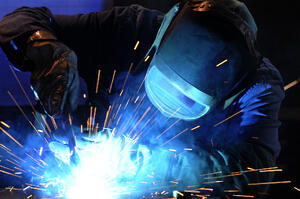 Over the years, the science of joining two lengths of metal has improved by leaps and bounds. From what was once a manual labor-intensive process requiring a large forge and hours of work, welding can now be done in a number of different ways.
Over the years, the science of joining two lengths of metal has improved by leaps and bounds. From what was once a manual labor-intensive process requiring a large forge and hours of work, welding can now be done in a number of different ways.
Gas-Based Welding
Many laymen are familiar with the concept of using an oxyacetylene torch to superheat two pieces of metal so that they can be joined. While this process can be done manually, there are many problems.
One, oxyacetylene and similar gas-based welding techniques rely on superheating the two metal objects being joined to fuse them together. Prolonged exposure to intense heat can compromise the structural integrity of some metals, reducing the tensile strength of the completed product.
Even if the two metals being joined are not compromised by their exposure to melting-point temperatures, it can be difficult to ensure that the joined metals can meet exacting tolerances.
Finally, this process is painfully slow compared to other welding techniques, as it takes time for the metal pieces being joined (or the filler material) to reach the temperature needed to ensure that a bond can be formed.
Arc Welding
Arc welding techniques, such as MIG or TIG welding, create an arc of electricity between an electrode and the material to be joined. As stated in Lincoln Electric’s explanation of arc welding, “the electrode can either be a rod with the purpose of simply carrying the current between the tip and the work. Or, it may be a specially prepared rod or wire that not only conducts the current but also melts and supplies filler metal to the joint.”
To put the above quote another way, the electrode can either be consumable, where it melts to become the material bonding two pieces of metal together, or it can be non-consumable, wherein the electrode doesn’t melt. If the electrode is non-consumable, then the metals being welded need to be heated to the point where they melt and provide a pool of material to join them, or there needs to be a filler material supplied to join the metal objects.
During arc welding, inert gases are used to prevent the metals being welded from reacting to nitrogen and oxygen in the air. This helps preserve the tensile strength of the metal being welded and prevent oxidation.
Resistance Welding
Resistance welding might sound similar to arc welding at first, as electricity plays a major role in the formation of welds in resistance welding processes as well. However, there are several key differences in resistance welding that separate it from arc welding.
First, and foremost, resistance welding does not rely on the use of filler material to join metal. Instead, resistance welding takes advantage of the innate resistance objects have to electrical current to create intense heat in the material in a tightly localized area, causing it to form a pool of molten material where the work pieces will be bonded. This resistance spot is different from the welds that an arc weld with filler material might make because it is located almost exclusively between the two work pieces being joined, rather than covering the area around where the weld is made.
Additionally, pressure is a much bigger factor in resistance welding than it is in arc welding. As stated in publications such as Miller Electric’s Resistance Spot Welding Guide, “Higher currents are necessary with greater pressure and, conversely, lower pressures require less amperage from the resistance spot welding machine.” When two pieces of metal are being joined with resistance welding, pressing them tightly together actually lowers their resistance to the electrical current. With lower electrical resistance, electricity passes easily, and the two metals don’t heat up as quickly and efficiently, making it harder to reach the high temperature needed to join the metals.
How long does it take for a resistance spot weld to complete? In some cases, a weld can be completed in as little as two milliseconds using a medium frequency direct current welding machine.
“Which Form of Welding is best for My Basket?”
The answer to this question actually depends on the type of metal being used for your custom basket.
For example, chrome-nickel stainless steel alloys have a very high electrical resistance, and cool off relatively fast. This makes stainless steel ideal for resistance welding, as these alloys will bond and solidify quickly with minimal distortion.
Most of Marlin’s custom basket designs use grade 304 or 316 stainless steel, as these alloys provide excellent corrosion resistance, tensile strength, and long-term cost-effectiveness.
However, other types of materials might not respond as optimally to resistance welding. For example, aluminum is highly conductive. This would mean that a resistance welder would have to consume an enormous amount of power to heat the aluminum enough to bond it. The same would be true of any especially ductile metal with a high melting point.
For highly ductile metals, MIG or TIG welding techniques that use a filler agent would be a good solution. This is one reason why Marlin Steel is dedicated to using a variety of welding equipment on the factory floor, as it ensures that the right tool for the job is always available.
Learn more about this and other custom basket design considerations by contacting Marlin Steel today!


.gif)


